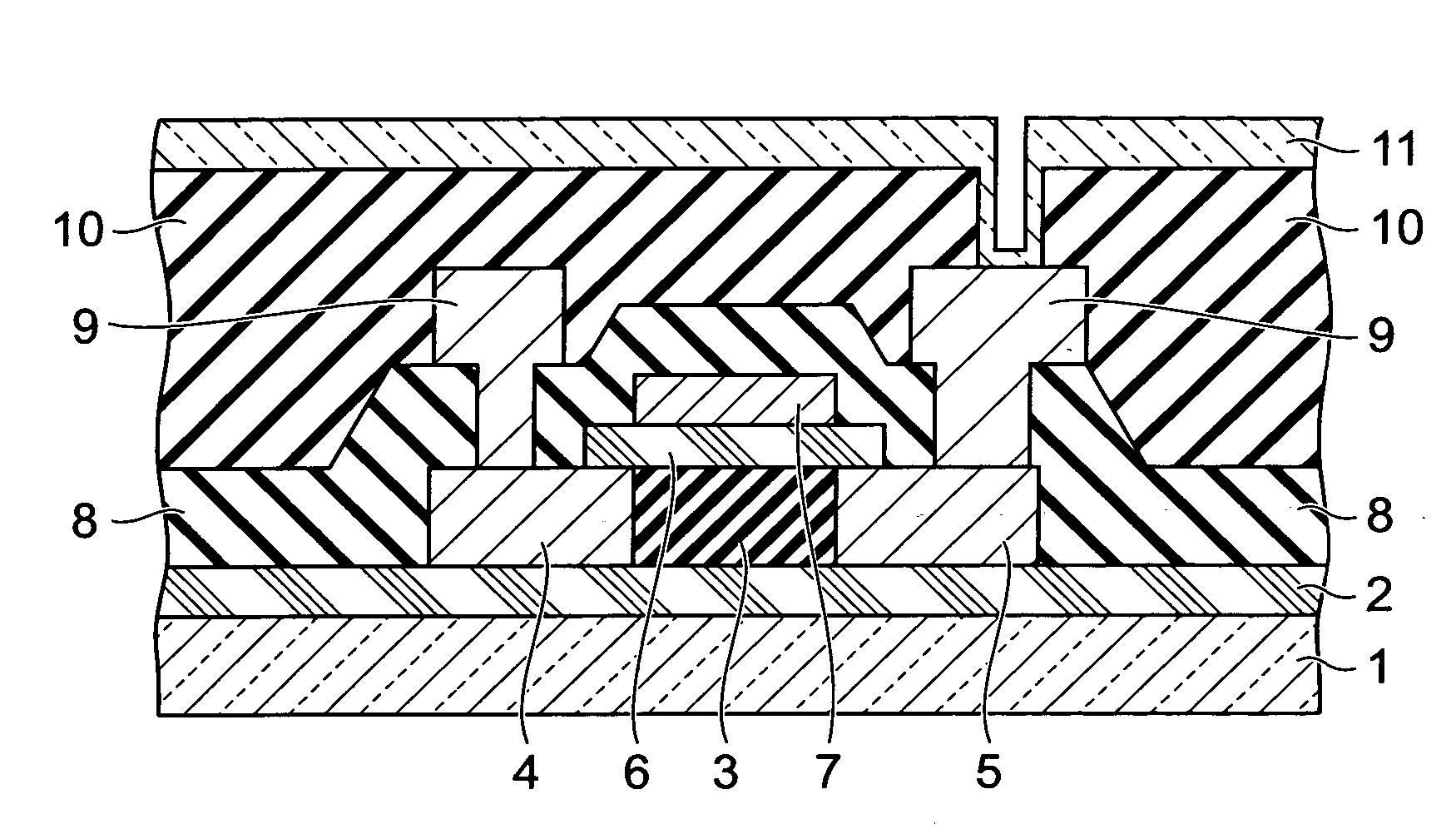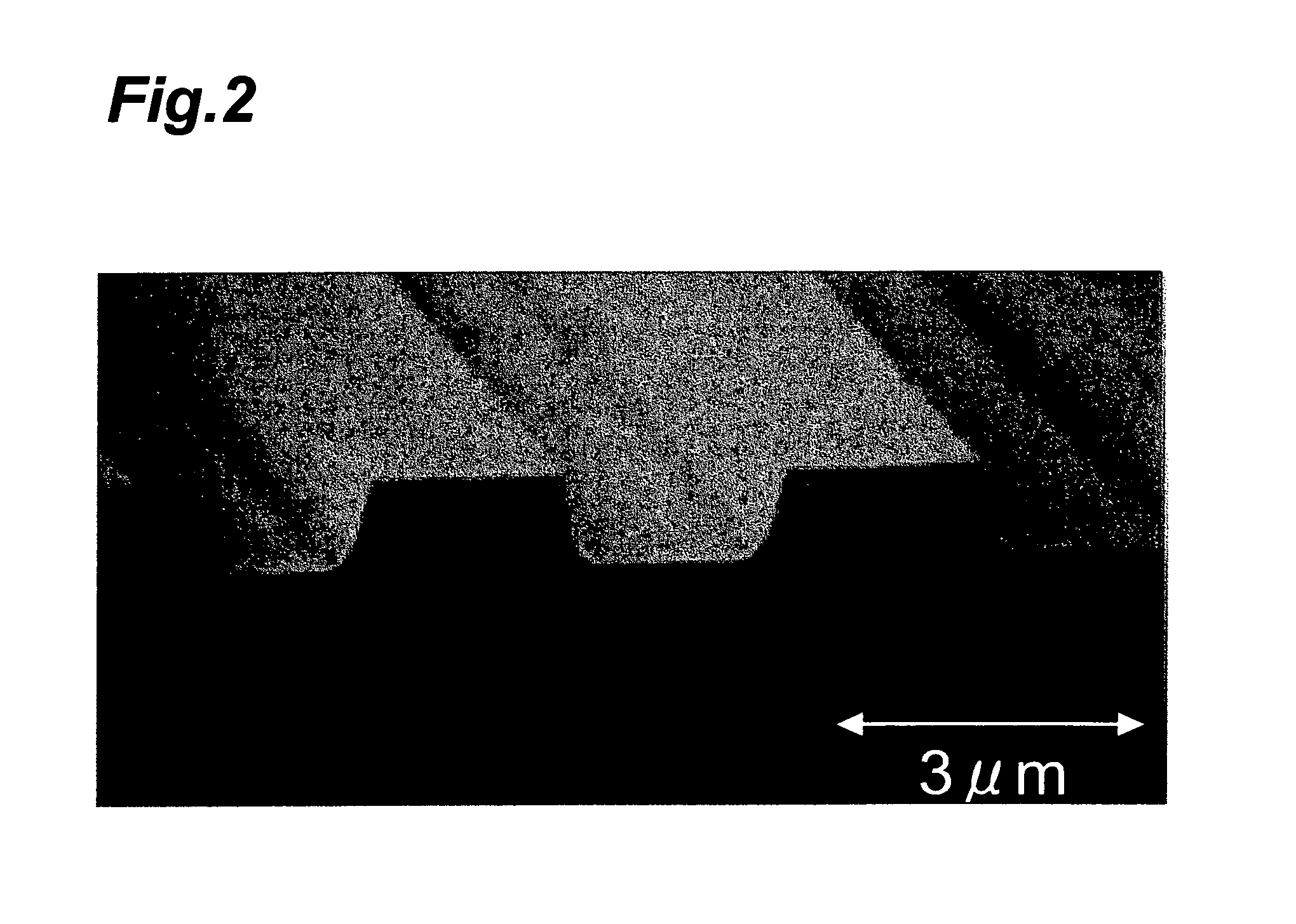Radiation curable composition, storing method thereof, forming method of cured film, patterning method, use of pattern, electronic components and optical waveguide
a technology of curable composition and forming method, which is applied in the direction of photomechanical equipment, instruments, photosensitive materials, etc., can solve the problems of complex steps requiring humidification treatment, light exposure dose, and difficulty in dipping in purified water after exposure, so as to improve pattern precision and improve pattern precision. , the effect of excellent pattern precision
- Summary
- Abstract
- Description
- Claims
- Application Information
AI Technical Summary
Benefits of technology
Problems solved by technology
Method used
Image
Examples
example 1
[0139]To a solution of 317.9 g of tetraethoxysilane and 247.9 g of methyltriethoxysilane in 1116.7 g of diethyleneglycol dimethyl ether there was added dropwise 167.5 g of nitric acid, prepared to 0.644 wt %, over a period of 30 minutes while stirring. After completion of the dropwise addition, reaction was conducted for 3 hours and then a portion of the produced ethanol and the diethyleneglycol dimethyl ether were distilled off under reduced pressure in a warm bath to obtain 1077.0 g of a polysiloxane solution. To 525.1 g of the polysiloxane solution there was added 53.0 g of diethyleneglycol dimethyl ether, a tetramethylammonium nitrate aqueous solution prepared to 2.38 wt % (pH 3.6) and 3.0 g of water, and the mixture was dissolved by 30 minutes of stirring at room temperature (25° C.) to obtain a polysiloxane solution for a radiation curable composition. The weight-average molecular weight of the polysiloxane was 830 as measured by GPC. Next, 0.193 g of a photoacid generator (PA...
example 2
[0141]To a solution of 96.13 g of tetraethoxysilane and 165.44 g of methyltriethoxysilane in 562.99 g of propyleneglycol methyl ether acetate there were added dropwise 75.47 g of nitric acid, prepared to 0.644 wt % and 18.9 g of a tetramethylammonium nitrate aqueous solution prepared to 2.38 wt % (pH 3.6), over a period of 5 minutes while stirring. After completion of the dropwise addition, reaction was conducted for 3 hours and then a portion of the produced ethanol and the propyleneglycol methyl ether acetate were distilled off under reduced pressure in a warm bath to obtain 359.94 g of a polysiloxane solution. Propyleneglycol methyl ether acetate was then added thereto to obtain 450.02 g of a polysiloxane solution for a radiation curable composition. The weight-average molecular weight of the polysiloxane was 1110 as measured by GPC. Next, 0.080 g of a photoacid generator (PAI-101, product of Midori Kagaku) was added to 20.0 g of the radiation curable composition polysiloxane sol...
example 3
[0143]To 10.0 g of the radiation curable composition polysiloxane solution obtained in Example 2 there was added 0.040 g of a photobase generator (NBC-101, product of Midori Kagaku), to prepare a radiation curable composition. The amount of component (a) used was 20 wt % with respect to the total radiation curable composition, the amount of component (b) used was 0.4 wt % with respect to the total radiation curable composition, and the amount of component (d) used was 0.1 wt % with respect to the total radiation curable composition.
[0144]A 2 mL portion of the radiation curable composition was added dropwise onto the center of a 6-inch silicon wafer and subjected to spin coating (30 seconds of rotation at 700 rpm) to form a coating on the wafer, and this was dried for 30 seconds on a 100° C. hot plate. Next, the dried coating was exposed to ultraviolet rays at 100 mJ / cm2 using an exposing apparatus (FPA-3000 iW, Canon) through a negative mask bearing a line pattern with a minimum lin...
PUM
| Property | Measurement | Unit |
|---|---|---|
| temperature | aaaaa | aaaaa |
| temperature | aaaaa | aaaaa |
| thickness | aaaaa | aaaaa |
Abstract
Description
Claims
Application Information
 Login to View More
Login to View More - R&D
- Intellectual Property
- Life Sciences
- Materials
- Tech Scout
- Unparalleled Data Quality
- Higher Quality Content
- 60% Fewer Hallucinations
Browse by: Latest US Patents, China's latest patents, Technical Efficacy Thesaurus, Application Domain, Technology Topic, Popular Technical Reports.
© 2025 PatSnap. All rights reserved.Legal|Privacy policy|Modern Slavery Act Transparency Statement|Sitemap|About US| Contact US: help@patsnap.com



